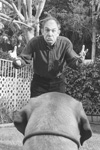How to Raise a Jewish Dog (7 page)
Read How to Raise a Jewish Dog Online
Authors: Rabbis of Boca Raton Theological Seminary,Barbara Davilman
Tags: #HUM007000


“Time to go. ” Signals to dog several things: (a) that someone’s shown up whom owner doesn’t want to talk to, (b) one of those
“troublemaking dogs” has arrived and the owner doesn’t want to spend the day at the vet’s, or (c) the owner has to pee.

“Bad dog! ” Useful when you need to scold dog and don’t want to make a scene.

“ I give up. Do what you want. ” This tells dog that you don’t know why you bother. Dog can also infer from this that he is
the most selfish creature on earth, and that you only hope one day the dog has a dog of his own who treats him with the kind
of disrespect and disobedience that he is showing you.
Practice this series of gestures and expressions in a mirror until you can convey them to the dog smoothly and without hesitation.
Note that, in the case of nonverbal communication, there is no effort at communicating subtext.
In each of these examples, the technique is the same: deliver the nonverbal message, confirm that it has not been understood
by the dog, then sigh heavily, invoke stage 2 of the Basic “Training” Procedure (“The Great Betrayal”), and feel sorry for
yourself.
With commands, we tell the dog what to do and what not to do and when to do or not do it.
Yes, it sounds harsh. And in conventional dog training programs, it often
is
harsh. In our program, however, this harshness is replaced by a sense of intimacy and comfort. To us, a command is a friendly
reminder and proceeds from the basic premise that there are no boundaries between you and the dog. The two of you are essentially
one organism, talking to itself, reminding itself of what it knows perfectly well it should do (or not do) and simply waiting
to “get with it.”
It would be impossible to illustrate every command to the dog, since the specific circumstances of life are infinite. So we’ve
focused on three absolutely essential commands that, if nothing else, will keep the dog under your control. They are “Sit,”
“Down,” and “Come.”
Of course, speaking to the dog is like speaking to a person: it’s often possible and sometimes even necessary to say the same
thing in different ways. That is why we have developed the Basic Commands in what we call the Five Modes.
The first three modes are “Casual,” “Emphatic,” and “Urgent.” The Casual Mode conveys a command that, while to be taken seriously,
is nonetheless meant in a spirit of easygoing calm. The Emphatic Mode asserts the master’s authority and makes it clear that
the command is an order, not a request. The Urgent Mode calls for immediate obedience.
Basic Commands: The Five Modes
| Casual | Emphatic | Urgent | Petulant | Hysterical | |
|---|---|---|---|---|---|
| Sit! | “So you’re going somewhere? ” | “Nu, you’re going to stand there all day?” | “What, would it kill you to sit down for one lousy second?” | “All right, fine. Don’t sit. Stand.” (The owner then leaves the room.) “All right, fine. Don’t sit. I’ll sit.”(Owner sits.) | IF YOU DON’T SIT RIGHT THIS SECOND, I SWEAR TO GOD IM NEVER GOING TO SPEAK TO YOU AGAIN, OKAY? |
| Down! | “What’s with the jumping? ” | “Were you told it was all right to jump up all over everybody?” | “Are you going to get down or am I talking to the wall?” | “Go ahead. Jump all you want. You always do.” (Owner leaves the room.) | IF YOU DONT GET DOWN RIGHT THIS SECOND, I SWEAR TO GOD I’lM NEVER GOING TO SPEAK TO YOU AGAIN, OKAY? |
| “So, excuse me, if it’s not too much trouble, could you come over here, please? ” | “Nu, I’m waving for you to come over here for my health?” | “What, Im here, you’re all the way over there—and thats okay with you?” | “Look, you want to be over there, fine. Im leaving.” (Owner leaves room.) | IF YOU DONT COME HERE RIGHT THIS SECOND, I SWEAR TO GOD IM NEVER GOING TO SPEAK TO YOU AGAIN, OKAY? |

“Casual” mode of commanding “Come! ”: Note how lightly ironic tone and elaborate courtesy respect dog’s intelligence.

“Emphatic” mode: Tone is slightly sharper, not because dog would disobey, but on the off chance he didn’t hear the first time.

“Urgent” mode: Use this type of command when dog hears you (because, believe us, he does) but you need to sell the gravity
of the situation.
There is also a fourth mode, “Petulant,” and a fifth called “Hysterical.” The Petulant Mode is to be employed only after the
first three have failed to elicit a satisfactory result. Hysterical is the mode of ultimatum and is to be followed by Situational
Martyrdom and/or Complete, if Temporary, Despair.

“Petulant” mode: Essential for dealing with dogs who respond only to extreme sarcasm or who have abandonment issues. (Not
shown: Owner turning and leaving)

“Hysterical” mode: Some dogs are easily bored and respond well when you throw in some theatrics with your commands.
All dogs, like all people, need and deserve praise. Bestowing praise is not only how we show the dog we love him, but is a
positive reinforcement to encourage him to repeat the praiseworthy behavior next time, assuming he can be bothered to listen.
Our method of praising our dogs differs slightly from other methods you may have seen or just naturally employ yourself. As
we mentioned earlier, one way we praise a dog is by delivering the praise, not to the dog himself, but to other people in
the vicinity. This, as we said, encourages the dog to believe that the whole world cares when he is good—and, conversely,
when he is bad.
Another important way of praising the dog consists in delivering the praise to the dog himself but making sure he remembers
that
we
still remember that we are a martyr to his badness. We accomplish this by attaching a criticism of some bad thing the dog
did either recently or, if need be, as far back as the beginning of time.